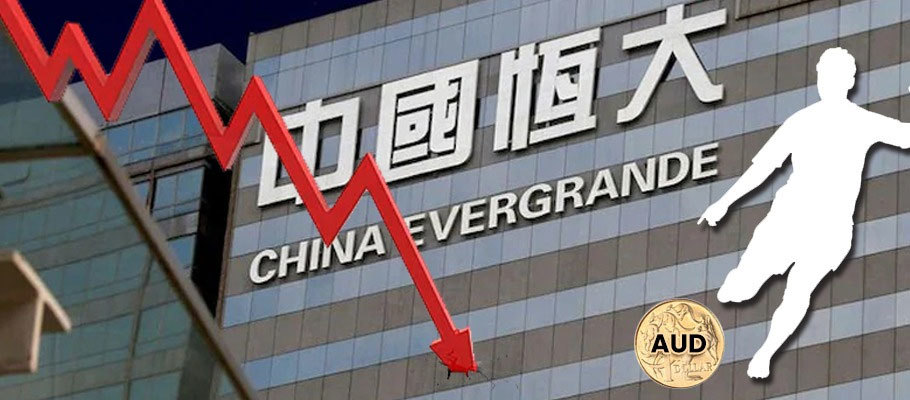
Published: September 24th, 2021
Sinking commodity prices and stock markets dragged down by the looming collapse of a too-big-to-fail Chinese property giant have put the Australian dollar on the back foot this week.
The Aussie was major-currencies laggard as the week began following the news that China's Evergrande property conglomerate was likely heading for default on its array of 170+ debt obligations, most with the world’s biggest banks.
Two interest payments due to bondholders this week, one for USD 83.4 million and one for CNY 230 million, are being seen as a crucial test of Evergrande’s solvency.
The impending crisis is just the latest shock to growth prospects for China’s economy, amid a crackdown by regulators on technology stock speculation and re-introduction of COVID-19 restrictions in some key industrial regions.
Those worries have sent prices for iron ore plunging, impacting one of commodity-reliant Australia’s major exports.
AUD/USD had dropped 0.4 per cent to 0.7325 at the time of publication, while GBP/AUD remained flat at 1.8800.
A forex research briefing from Barclays said Australia and New Zealand’s currencies ‘would likely remain weighed down thanks to worries about weaker China growth, especially given the impending pressure on China’s property sector.’
The Evergrande crisis confirms what many market pundits had been saying for months, namely that parts of China's booming property market were over-leveraged and driven by wild speculation. For some investors, it raises questions about China’s ability to continuously deliver double-digit economic growth.
Authorities in Beijing seem willing to allow the company to fail, warning others that unhinged risk in any market will have severe consequences.
The hardline approach is part of a wider crackdown on what authorities have called 'irresponsible capitalism', with the country’s technology giants first on the list for correction.
President Xi Jinping arguably signalled what was to come when he spoke to the Communist Party’s 19th National Congress back in October 2017. ‘Houses’, he told those in attendance ‘are for living in, not speculating’.
The statement ‘laid bare government concerns about overheating property markets while housing prices made ownership unaffordable for many,’ according to an analysis by The Institute of Chinese Studies.
Evergrande is the single largest borrower in Asia’s high-yield, dollar-denominated debt market. The company’s books for 2020 show liabilities worth more than USD 300 billion, all of which look to be in danger of default.
Analysts at UBS told Bloomberg that the cascade of worries weighing on Evergrande and China's broader property/construction ecosystem lead them to believe that ‘some sort of credit event is inevitable’.
"The test will be Evergrande’s ability to find enough near-term liquidity in asset disposals and sales already on the books. If that turns out to have deteriorated considerably, then the likelihood of a credit event goes up sooner rather than later.
As other Chinese property stocks slumped at the beginning of the week, investors took the combined news as evidence that AsiaPac’s real estate sector is under intense pressure.
Listed property stocks in Hong Kong suffered their biggest one-day selloff in more than a year, while in Australia, the prospect of a property market crash threatened to extinguish demand for iron ore, down under’s number one export and foreign exchange driver.
Although much of the country has been sent back into COVID-19 lockdown by the surging delta variant, iron ore exports have kept the economy buzzing and its balance of trade figures in the black. Falling prices for such a strategic commodity could hamper economic growth in the near term.
Iron ore prices slumped to below USD 100 per ton at the start of this week’s session. Analysts blamed the Evergrande situation and pointed to new government restrictions on commercial activity in industrial areas due to Covid lockdowns.
Any softening in commodity earnings or exports could provide the Reserve Bank of Australia (RBA) with more reason for caution as it contemplates an end to quantitative easing and rising interest rates, which would pressurise the Aussie.
The RBA delayed reducing its quantitative easing programme once already in September, moving it to February of next year thanks to national lockdowns. A rate rise, it seems, is still some way off.
The latest developments in global markets will likely spur investors to bet on the timing of that first-rate rise being pushed back to 2023 and some money market bets predicting lift-off as far out as 2024.
‘AUD is still at risk of continuing a pattern of underperformance in the near term,’ said Barclay’s. Last week’s weak labour market data for August and dovish comments from the RBA will stack up against a price rise'.
The aussie’s gloomy streak actually began last week (wc 13 September), triggered by a blend of unhappy global equity markets, earlier downbeat data from China, and hostile reserve bank policy.
AUD was sluggish through the week’s session, with Reuters saying both technical and fundamental analysis is signalling more declines.
An analysis by Reuters Currency Markets said, '’risk-sensitive AUD looks to be on track for a deeper drop if the corrections we see in equity markets become more pronounced and China's recovery goes off the rails.’
The losing streak engulfing global markets is now finishing its third week, an unsupportive environment for the 'high beta' Aussie, which tends to track lower against stock indices.
‘In a risk-off environment, commodity currencies like AUD and NZD are both vulnerable,’ said Reuters. ‘We think EUR could be the one to watch, potentially outperforming SEK, NOK and GBP.’
A torrent of downbeat economic numbers from China last week added credence to the emerging narrative of decelerating growth in Australia's top export market.
Retail sales fell 2.5 per cent in the year to August, while manufacturing output dipped to 5.2 per cent in the year to August from 6.3 per cent in the year to July.